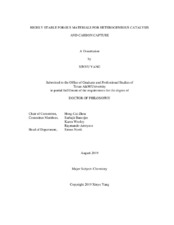| dc.description.abstract | Metal-organic frameworks (MOFs) and porous polymer networks (PPNs) are emerging porous materials that exhibit high crystallinity, large surface areas, and excellent tunability. With these features, MOFs and PPNs demonstrate great potentials in heterogeneous catalysis, gas storage/separation, chemical sensing, and biomedical application. This dissertation is focusing on the synthesis of highly stable MOFs and PPNs, and their applications in heterogeneous catalysis and carbon capture. In the first project, core-shell MOF, PCN-222@Zr-BPDC, was synthesized through one-step strategy under the guidance of nucleation kinetics analysis. The stability, crystallinity, porosity, and structure of PCN-222@Zr-BPDC were characterized. Then, a series of multifunctional core-shell MOFs were synthesized by isoreticular expansion of microporous shell and orthogonal modification of mesoporous core. Taking advantage of the biomimetic catalytic center and adjustable window size, the core-shell MOFs work as an ideal platform for heterogeneous catalysis. In the second project, I further explored the above-mentioned synthetic strategy. First, four zirconium core-shell MOFs with needle-like cores and octahedral shells were prepared. To demonstrate the versatility of the kinetically controlled strategy, a series of core-shell MOFs with mismatching lattice and different metals were synthesized. With the well-defined pores, the core-shell MOFs persist excellent shape and size selectivity in olefin epoxidation.
In the third project, three alkylamine tethered PPNs were developed. A novel postsynthetic modification strategy was proposed to construct alkylamine tethered PPNs to replace the liquid amine that was widely used in post-combustion carbon capture. By utilizing the polarizability and quadrupole moment of CO2, the materials showed significant increases in CO2 uptake capacities and high CO2/N2 selectivity. In summary, a series of highly stable porous materials have been synthesized for different applications. In particular, the nucleation kinetics control has been demonstrated as a facile strategy to synthesize hybrid core-shell MOFs and anchor installation shows great potential in carbon capture. | en |


